
views
How do you find your family’s crest?

Search your paternal family name on a genealogy website. The right to use a coat of arms is granted to one person. In many cases, that person’s male descendants are entitled to use the same coat of arms—including the same crest. To find out whether you’re entitled to use a specific crest, go back through the male line of your family history as far as you can. Crests became popular additions to coats of arms around the 16th century, so try to track your family line back that far, if you can. Genealogy websites like Ancestry.com, FamilySearch, MyHeritage, and Genealogy.com are a great place to start when you’re researching your family lineage. As you research, pay attention to changes in the spelling of your family’s surname. “There are tons of resources for researching your genealogy,” notes author and journalist A.J. Jacobs. “Start with aggregators like Cyndi’s List or services like Ancestry.com or MyHeritage. The LDS Church also has genealogical resources for those interested. Don’t be afraid to reach out for help—people in the genealogy world love to share knowledge.”

Ask older relatives if they know of a coat of arms. Don’t underestimate the importance of in-person research—talk to family members, especially older ones, to see if they remember anyone having a family coat of arms. Usually, if there was a coat of arms in your family’s history, that knowledge would have been passed down through the generations. Once you’ve traced your family’s history, you may also be able to contact a historian who’s knowledgeable about the history of heraldry in the village or town where your family originated.
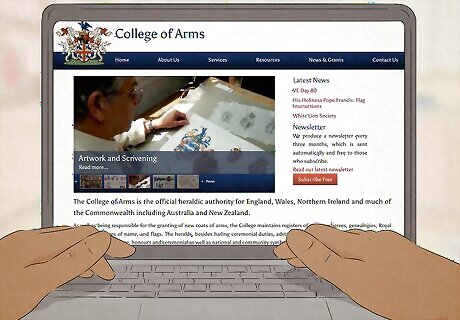
Compare your ancestors’ names to armoury records. As you dig into your family records, compare the names of your direct male ancestors to records of known armigers (people who had the right to use a coat of arms). Be aware that this can involve extensive research—some resources are available online, but many records have never been digitized. In the UK (except Scotland), the College of Arms in London maintains records regarding coats of arms. If your research indicates you may be entitled to use a coat of arms, you can pay a fee to the College of Arms to have them verify your claim. In Scotland, the main authority that grants heraldry is the Court of Lord Lyon. Although many websites claim to match you with your family’s coat of arms or crest for a fee, these are generally not considered reputable.

Verify that you’re a direct descendant of the armiger. It’s important to note that coats of arms and crests belong to an individual, not a family—you can directly inherit a crest from an ancestor, but it’s not automatically granted to everyone who shares that person’s surname. Female descendants are sometimes given permission to use their ancestral heraldry, typically if there are no male descendants.
How to Get a Family Crest

Petition the King of Arms to apply for a family coat of arms. The Crown sometimes grants applications for a family coat of arms. This is typically done for residents of the UK who have demonstrated excellence in some way—like receiving military honors or a lifetime of charitable work. If you believe you qualify, submit a petition (also called a memorial) to the Earl Marshal of the College of Arms, and pay the required fees. If your petition is approved, the King of Arms will begin designing the coat of arms and the crest. You can request certain elements, but the design of the heraldry will be up to the King of Arms.
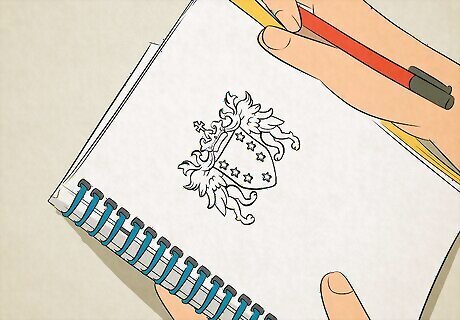
Make your own coat of arms if you aren’t entitled to one. Designing your own coat of arms can be a fun, meaningful project for you and your family. Choose elements that speak to you—the colors and designs on coats of arms are often symbolic. Even if it’s never registered or “official,” you can still use your family’s coat of arms and pass it down to future generations. Jump to the next section to learn more about what to include in your coat of arms.
Elements of Family Coats of Arms
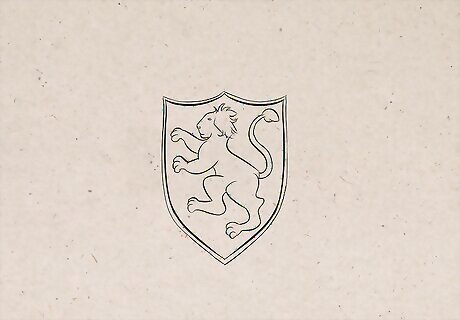
Every coat of arms contains a shield. The shield (sometimes called the escutcheon) is the large piece at the center of the coat of arms. The main design of the coat of arms is placed on the shield. The shields are usually shaped like a traditional shield, but they can sometimes be round, oval, or diamond-shaped. Shields can be solid-colored, decorated with an ordinarie (like a stripe, cross, or chevron), or divided into halves or quarters. Decorative emblems called charges are often added to the shield. These can either be one large object or a smaller object repeated across the shield. Crosses, stars, flowers, and animals like lions or rabbits are commonly used as charges.
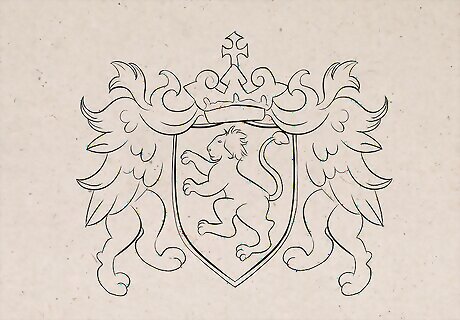
Optional elements include the helmet, crest, and mantle. Typically, a helmet sits on top of the shield. The shape and style of the helmet often had significance for the wearer’s status—an open helmet was often reserved for nobles and high-ranking officials. The crest sits at the very top of the coat of arms, usually on top of a wreath of twisted fabric. Flowing fabric called a mantle is often draped around the shield. Figures called supporters are sometimes depicted on either side of the shield. Supporters can be animals, people, plants, or decorative objects. If the supporters are standing on anything, that’s called the compartment. A banner with a motto often decorates the bottom of the coat of arms.
Colors & Symbols on a Coats of Arms
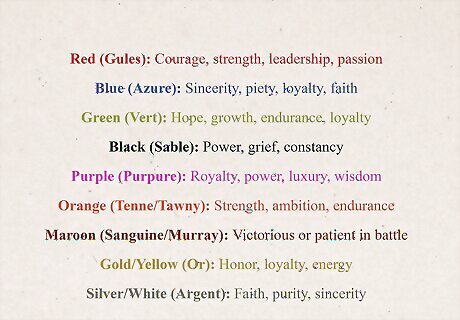
Colors are often used symbolically in coats of arms. The most popular colors for coats of arms are red, blue, green, black, and purple. Decorations are often done in one of the two “metals”—gold/yellow and silver/white. Each color—and metal—has significance in heraldry. It’s traditional to refer to these colors with their heraldic names, typically derived from French. Here’s what each color means in a coat of arms: Red (Gules): Courage, strength, leadership, passion Blue (Azure): Sincerity, piety, loyalty, faith Green (Vert): Hope, growth, endurance, loyalty Black (Sable): Power, grief, constancy Purple (Purpure): Royalty, power, luxury, wisdom Orange (Tenne/Tawny): Strength, ambition, endurance Maroon (Sanguine/Murray): Victorious or patient in battle Gold/Yellow (Or): Honor, loyalty, energy Silver/White (Argent): Faith, purity, sincerity
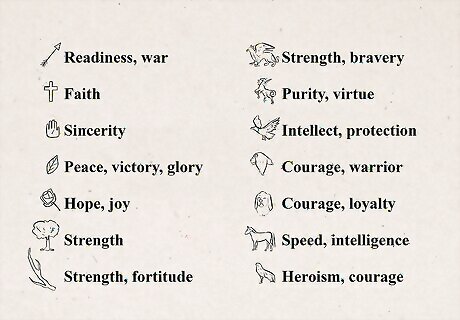
Decorative items may also be symbolic. When designing a coat of arms, decorative elements like the charges, crest, and supporters are often chosen to convey something about the individual who will bear the coat of arms. Here are some popular symbols used in coats of arms: Arrow: Readiness, war Cross: Faith Hand: Sincerity Bay leaves: Peace, victory, glory Flowers: Hope, joy Tree: Strength Antlers: Strength, fortitude Griffin: Strength, bravery Unicorn: Purity, virtue Eagle: Intellect, protection Lion: Courage, warrior Dog: Courage, loyalty Horse: Speed, intelligence Rooster: Heroism, courage
What is a family crest?
A crest is a decorative object above the helmet on a coat of arms. The crest is usually attached to the helmet by twisted cloth called the “wreath of the colors.” Initially, the crests that decorated coats of arms were probably designed to look like the real heraldic crests that knights wore on top of their helmets during tournaments and battles. The original crests were made of lightweight materials like leather or wood, although they were sometimes made of metal. They were a way to make the knight recognizable to others on the battlefield or tournament grounds. Crests often take the form of horns, animals, mythological creatures or geometric design. A coat of arms is sometimes incorrectly referred to as a crest. However, the crest is only one element on a coat of arms. Not all coats of arms have crests, although most of them do.
Is a coat of arms the same as a family crest?
A family crest is not the same thing as a coat of arms. A coat of arms is the entire heraldry design, including a shield, crest, mantle, and motto. The crest is just the small decoration that sits on top of the shield. Not every coat of arms has a crest, but almost every crest is part of a coat of arms.
Do all families have a family crest?
No, most families don’t have a coat of arms or a crest. Coats of arms were only given to certain high-ranking families in medieval Europe. Even if someone in your family did have a coat of arms, you’d have to be their direct descendant along the male line to have a claim to it. It’s actually fairly uncommon to discover that you have a coat of arms—most people who have the right to one will already know about it.
FAQs
When did people start using coats of arms? Heraldry, or the use of coats of arms, began in the 1100s. Because knights wore helmets and heavy armor, it was hard to know who was who on the battlefield and in tournaments. Knights began painting brightly-colored symbols on their shields and banners so they could be easily identified.
How do I find out what my family crest means? Examine the colors and symbols on the crest. Each element may have a meaning—a red lion might indicate military strength, for instance, while a blue banner might indicate loyalty. When you’re examining the crest, check for any puns (called “cants” in heraldry). For instance, Sir Roger de Trumpington had two trumpets on his coat of arms, and Odinel Heron had three herons.
What right do I have to use a family crest from history? If you’re the direct descendant (along the male line) of someone who had a coat of arms, you’re likely entitled to use it. If you’re not descended from a person who had a particular coat of arms, you can’t use it—and in some places, like Scotland, using a coat of arms you’re not entitled to is a criminal offense.











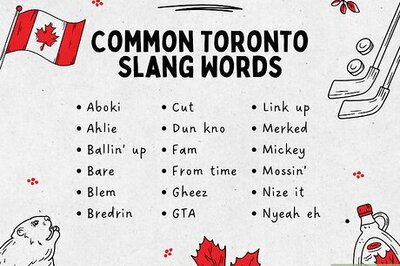


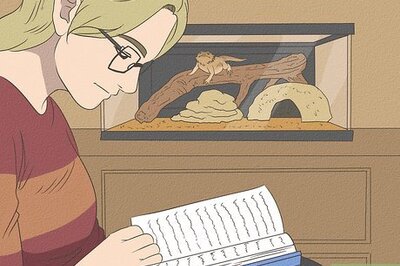


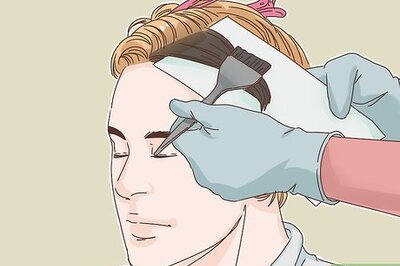

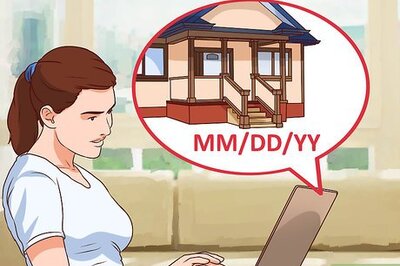
Comments
0 comment